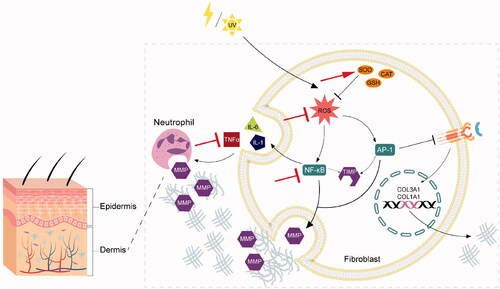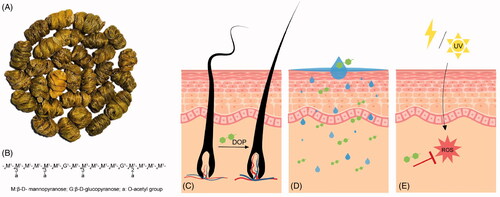Figures & data
Figure 1. Skin aging via oxidative mechanism and the antiaging effect of DOP. The internal cause of skin aging occurs in the dermis, which is a dense network of fibres and elastic tissue. ROS are generated by UV radiation and other factors. In direct or indirect ways, ROS can activate various intracellular kinases leading to the production of AP-1 and NF-κB. Activated AP-1 and NF-κB regulate the transcription of matrix MMPs, which can degrade collagen and elastin. In addition, NF-κB is a major activator of inflammatory cellular infiltration by inducing the production of pro-inflammatory cytokines TNF-α, IL-1 and IL-6, which stimulates further production of MMPs. ROS-induced AP-1 also down-regulates the TGF-β receptor and impairs subsequent cascade and pathways, which cause the reduction of collagen type I and III. Ultimately, the collagen and elastin level in dermal layer is reduced and therefore accelerating skin aging. DOP can achieve antiaging functions by defensing oxidative damage in the following aspects, including enhancing antioxidant enzyme system (red arrow), decreasing ROS, inhibiting NF-κB and inhibiting inflammatory response (red T icon). DOP: Polysaccharides of D. officinale; ROS: Reactive Oxygen Species; AP-1: Activator Protein-1; NF-κB: Nuclear Factor-kappa B; MMPs: Matrix Metalloproteinase; TNF-α: Tumour Necrosis Factor-α; IL-1β: Interleukin-1beta; TGF-β: Tumour Growth Factor-β.

Figure 2. Pharmacological effects of DOP in dermatology. (A) Dendrobium officinale. (B) Dendronan. Primary structure of DOP is mainly composed of O-acetylated sugar residues. (C) Hair growth promoting effect of DOP. (D) Skin-moisturising effect of DOP. (E) Antioxidant effect of DOP. DOP: Polysaccharides of D. officinale.

Table 1. The potential effect of Dendrobium officinale in cosmetics.
